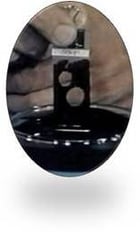Capillarity
Capillarity is defined as movement of a liquid along the surface of a solid caused by the attraction of molecules in the liquid to the molecules of the solid.
Experiment
Let's head to the lab, where we will conduct several experiment depicting successful capillary action,  then capillarity which is inhibited by several factors.
then capillarity which is inhibited by several factors.
Test 1: Here, we have two glass plates, with shims of equal size, 0.0015" or 0.381mm, inserted at the top and bottom. This gives us an ideal spacing for capillary action to occur.
Let's see what happens when we dip the bottom into a tray of liquid.
As you can see, the liquid has been drawn up smoothly by capillarity to fill the entire clearance between the plates.
 This illustrates the value of a close and uniform clearance for successful capillarity during brazing.
This illustrates the value of a close and uniform clearance for successful capillarity during brazing.
Test 2: Next, we will demonstrate what happens when we don't have a proper, uniform clearance. These plates are separated by a 0.0015" or 0.038mm shim at the bottom, and a heavier shim of 0.015" or 0.381mm at the top. 
Now, when we insert the plates into the tray, we see the liquid
can only rise part way. Capillary action will draw the liquid
only to the point where the clearance is 0.005 - 0.006" or 0.127
- 0.152mm. Then the gap becomes too large, and capillarity
cannot take place.
Remember, in our first test, the liquid filled the gap between the plates completely because the space was uniform, so capillarity could operate.
Test 3: For our next experiment, we have glass plates separated by shims representing an ideal, uniform clearance of 0.0015" or 0.038mm. But the inside surfaces of the glass have been marked with greasy fingerprints.
When we insert these plates into the tray, the liquid rises to fill the gap. However, it leaves voids where the oily surfaces interfere with capillarity. If this were a braze joint, it would not be a sound one.
 From these illustrations, we can understand several principles relating to capillarity and brazing.
From these illustrations, we can understand several principles relating to capillarity and brazing.
First, joint gaps must be of correct, uniform size for capillary action to occur. Variation in spacing will affect the success of your brazing operation because capillarity will be compromised.
Second, cleanliness counts in brazing. Parts that are not properly cleaned may carry grease or other debris which will impede the process of capillarity.
Successful capillary action-the process that allows alloys to flow into the joint between two metal parts-is crucial to successful brazing. For more information from Lucas-Milhaupt on proper brazing procedures, click here.
Questions? Lucas-Milhaupt experts can help you navigate the challenges of joining metals. For information on brazing products or services, click here or contact us.

